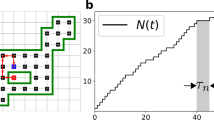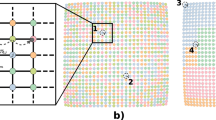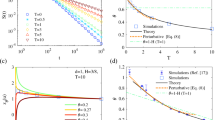Abstract
How long does it take a random walker to reach a given target point? This quantity, known as a first-passage time (FPT), has led to a growing number of theoretical investigations over the past decade1. The importance of FPTs originates from the crucial role played by first encounter properties in various real situations, including transport in disordered media2,3, neuron firing dynamics4, spreading of diseases5 or target search processes6,7,8,9. Most methods of determining FPT properties in confining domains have been limited to effectively one-dimensional geometries, or to higher spatial dimensions only in homogeneous media1. Here we develop a general theory that allows accurate evaluation of the mean FPT in complex media. Our analytical approach provides a universal scaling dependence of the mean FPT on both the volume of the confining domain and the source–target distance. The analysis is applicable to a broad range of stochastic processes characterized by length-scale-invariant properties. Our theoretical predictions are confirmed by numerical simulations for several representative models of disordered media10, fractals3, anomalous diffusion11 and scale-free networks12.
This is a preview of subscription content, access via your institution
Access options
Subscribe to this journal
Receive 51 print issues and online access
$199.00 per year
only $3.90 per issue
Buy this article
- Purchase on Springer Link
- Instant access to full article PDF
Prices may be subject to local taxes which are calculated during checkout


Similar content being viewed by others
References
Redner, S. A Guide to First-Passage Processes (Cambridge Univ. Press, Cambridge, UK, 2001); Errata 〈http://physics.bu.edu/~redner/〉
Havlin, S. & ben-Avraham, D. Diffusion in disordered media. Adv. Phys. 36, 695–798 (1987)
ben-Avraham, D. & Havlin, S. Diffusion and Reactions in Fractals and Disordered Systems (Cambridge Univ. Press, Cambridge, UK, 2000)
Tuckwell, H. C. Introduction to Theoretical Neurobiology (Cambridge Univ. Press, Cambridge, UK, 1988)
Lloyd, A. L. & May, R. M. Epidemiology — how viruses spread among computers and people. Science 292, 1316–1317 (2001)
Bénichou, O., Coppey, M., Moreau, M., Suet, P. H. & Voituriez, R. Optimal search strategies for hidden targets. Phys. Rev. Lett. 94, 198101 (2005)
Bénichou, O., Loverdo, C., Moreau, M. & Voituriez, R. Two-dimensional intermittent search processes: An alternative to Lévy flight strategies. Phys. Rev. E 74, 020102 (2006)
Shlesinger, M. F. Mathematical physics: Search research. Nature 443, 281–282 (2006)
Eliazar, I., Koren, T. & Klafter, J. Searching circular DNA strands. J. Phys. Condens. Matter 19, 065140 (2007)
Bouchaud, J.-P. & Georges, A. Anomalous diffusion in disordered media: statistical mechanisms, models and applications. Phys. Rep. 195, 127–293 (1990)
Metzler, R. & Klafter, J. The random walk’s guide to anomalous diffusion: a fractional dynamics approach. Phys. Rep. 339, 1–77 (2000)
Gallos, L. K., Song, C., Havlin, S. & Makse, H. A. Scaling theory of transport in complex biological networks. Proc. Natl Acad. Sci. USA 104, 7746–7751 (2007)
Van den Broeck, C. Renormalization of first-passage times for random walks on deterministic fractals. Phys. Rev. A 40, 7334–7345 (1989)
Yuste, S. B. First-passage time, survival probability and propagator on deterministic fractals. J. Phys. A 28, 7027–7038 (1995)
Song, C., Havlin, S. & Makse, H. A. Self-similarity of complex networks. Nature 443, 392–395 (2005)
Rice, S. A. Diffusion-Limited Reactions (Elsevier, Amsterdam, 1985)
Berg, O. G., Winter, R. B. & von Hippel, P. H. Diffusion-driven mechanisms of protein translocation on nucleic acids. 1. Models and theory. Biochemistry 20, 6929–6948 (1981)
Coppey, M., Bénichou, O., Voituriez, R. & Moreau, M. Kinetics of target site localization of a protein on DNA: A stochastic approach. Biophys. J. 87, 1640–1649 (2004)
Holcman, D. Modeling DNA and virus trafficking in the cell cytoplasm. J. Stat. Phys. 127, 471–494 (2007)
Barabasi, A. L. & Albert, R. Emergence of scaling in random networks. Science 286, 509–512 (1999)
Han, J.-D. J. et al. Evidence for dynamically organized modularity in the yeast protein–protein interaction network. Nature 430, 88–93 (2004)
Almaas, E., Kovacs, B., Vicsek, T., Oltvai, Z. N. & Barabasi, A. L. Global organization of metabolic fluxes in the bacterium Escherichia coli . Nature 427, 839–843 (2004)
Hughes, B. D. Random Walks and Random Environments (Oxford Univ. Press, New York, 1995)
Noh, J. D. & Rieger, H. Random walks on complex networks. Phys. Rev. Lett. 92, 118701 (2004)
Barton, G. Elements of Green Functions and Propagation: Potentials, Diffusion and Waves (Oxford Univ. Press, New York, 1989)
Condamin, S., Bénichou, O. & Moreau, M. First-passage times for random walks in bounded domains. Phys. Rev. Lett. 95, 260601 (2005)
Montroll, E. W. Random walks on lattices. iii. Calculation of first-passage times with application to exciton trapping on photosynthetic units. J. Math. Phys. 10, 753–765 (1969)
Bollt, E. M. & ben-Avraham, D. What is special about diffusion on scale-free nets? N. J. Phys. 7, 26–47 (2005)
Albert, R., Jeong, H. & Barabasi, A. L. Internet: Diameter of the world-wide web. Nature 401, 130–131 (1999)
Song, C., Havlin, S. & Makse, H. A. Origins of fractality in the growth of complex networks. Nature Phys. 2, 275–281 (2006)
Acknowledgements
We are grateful to J. M. Victor for discussions.
Author information
Authors and Affiliations
Corresponding author
Ethics declarations
Competing interests
The authors declare no competing financial interests.
Supplementary information
Supplementary Equations
The file contains Supplementary Equations with details on calculations involved in the main text. (PDF 523 kb)
Rights and permissions
About this article
Cite this article
Condamin, S., Bénichou, O., Tejedor, V. et al. First-passage times in complex scale-invariant media. Nature 450, 77–80 (2007). https://doi.org/10.1038/nature06201
Received:
Accepted:
Issue Date:
DOI: https://doi.org/10.1038/nature06201
This article is cited by
-
The first-passage-time moments for the Hougaard process and its Birnbaum–Saunders approximation
Statistics and Computing (2023)
-
Bayesian deep learning for error estimation in the analysis of anomalous diffusion
Nature Communications (2022)
-
Everlasting impact of initial perturbations on first-passage times of non-Markovian random walks
Nature Communications (2022)
-
Universal kinetics of imperfect reactions in confinement
Communications Chemistry (2021)
-
Molecular motion and tridimensional nanoscale localization of kindlin control integrin activation in focal adhesions
Nature Communications (2021)
Comments
By submitting a comment you agree to abide by our Terms and Community Guidelines. If you find something abusive or that does not comply with our terms or guidelines please flag it as inappropriate.



